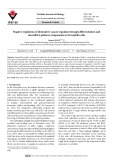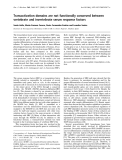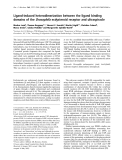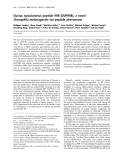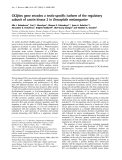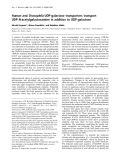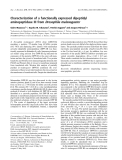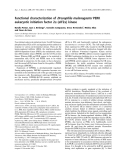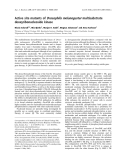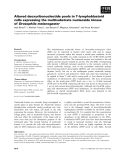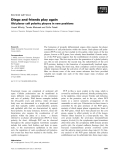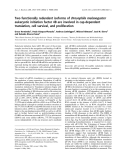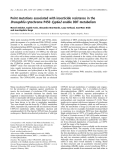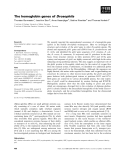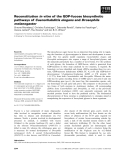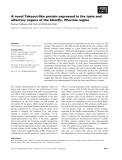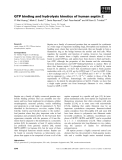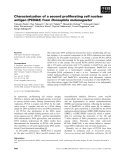
Drosophila cells
-
Drosophila model is intensively studied for the development of cancer. The diminutive (dMyc), a homolog of the human MYC gene, is responsible for cell- apoptosis and its upregulation is responsible for determining the fate of cancerous growth in humans and Drosophila model. This work implores the requirement of dMyc and its expression as one of the major regulator of cancer with other proteins and repression of dMyc mRNA in Drosophila S2 cells.
 7p
7p  thiencuuchu
thiencuuchu
 27-11-2021
27-11-2021
 15
15
 1
1
 Download
Download
-
The transcription factor serum response factor (SRF) regulates expression of growth factor-dependent genes and muscle-specific genes in vertebrates. Homologous factors regulate differentiation of some ectodermic tissues in invertebrates. To explore the molecular basis of these different physiological functions, the functionality of human, Drosophila melanogaster and Artemia franciscana SRFs in mammalian cells has been compared in this article. D. melanogaster and, to a lesser extend, A.
 9p
9p  system191
system191
 01-06-2013
01-06-2013
 32
32
 5
5
 Download
Download
-
The insect ecdysteroid receptor consists of a heterodimer between EcR and the RXR-orthologue, USP. We addressed the question of whether this heterodimer, like all other RXR heterodimers, may be formed in the absence of ligand and whether ligand promotes dimerization. We found that C-terminal protein fragments that comprised the ligand binding, but not the DNA binding domain of EcR and USP and which were equipped with the activation or DNA binding region of GAL4, respectively, exhibit a weak ability to interact spontaneously with each other.
 9p
9p  system191
system191
 01-06-2013
01-06-2013
 28
28
 3
3
 Download
Download
-
Most (78%) mitochondrial genomes in the studied mutant strain of Drosophila subobscura have undergone a large-scale deletion (5 kb) in the coding region. This mutation is stable, and is transmitted intact to the offspring. This animal model of major rearrangements of mitochondrial genomes can be used to analyse the involvement of the nuclear genome in the production and maintenance of these rearrangements.
 8p
8p  research12
research12
 01-06-2013
01-06-2013
 50
50
 6
6
 Download
Download
-
We have characterized a glycosylated, 31 amino-acid peptide of 4932 Da isolated from Drosophila melanogaster males. The mature peptide contains a sugar moiety of 1184 Da at a NDT consensus glycosylation site and a disulfide bond. It is synthesized in the male ejaculatory duct via a 54 amino-acid precursor containing an N-terminal signal peptide and Arg-Lys at the C-terminus which is cleaved off during maturation. The gene contains an intron of 53 bp and is localized in the cytological region 99B of the D. melanogaster genome....
 9p
9p  research12
research12
 01-06-2013
01-06-2013
 39
39
 4
4
 Download
Download
-
An earlier described CK2btes gene of Drosophila melano-gasteris shown to encode amale germline speci®c isoformof regulatory bsubunit of casein kinase 2. Western-analysis using anti-CK2btes Ig revealed CK2btes protein in Drosophila testes extract. Expression of a CK2btes± b-galactosidase fusion protein driven by the CK2btes pro-moter was found in transgenic ¯ies at postmitotic stages of spermatogenesis.
 10p
10p  research12
research12
 29-04-2013
29-04-2013
 30
30
 4
4
 Download
Download
-
A putativeDrosophilanucleotide sugar transporter was characterized and shown to be theDrosophilahomologue of the human UDP-Gal transporter (hUGT). When the Drosophila melanogasterUDP-Gal transporter (DmUGT) was expressed in mammalian cells, the transporter protein was localized in the Golgi membranes and complemented the UDP-Gal transport de®ciency of Lec8 cells but not the CMP-Sia transport de®ciency of Lec2 cells.
 11p
11p  research12
research12
 29-04-2013
29-04-2013
 29
29
 2
2
 Download
Download
-
Themosquito,Anopheles gambiae, is an important vector of Plasmodium falciparum malaria. Full genome analysis revealed that, as in Drosophila melanogaster,the enzyme glutathione reductase is absent inA. gambiaeand func-tionally substituted by the thioredoxin system. The key enzyme of this system is thioredoxin reductase-1, a homo-dimeric FAD-containing protein of 55.3 kDa per subunit, which catalyses the reaction NADPH + H + + thio-redoxin disulfidefiNADP + + thioredoxin dithiol.
 10p
10p  tumor12
tumor12
 20-04-2013
20-04-2013
 31
31
 3
3
 Download
Download
-
A Drosophila melanogaster cDNA clone (GH01916) encoding a putative 723-residue long (82 kDa) protein (CG 7415) and displaying 50% identity with mammalian cytosolic dipeptidyl aminopeptidase (DPP) III was func-tionally expressed in Schneider S2 cells. Immunocytochemi-cal studies using anti-(rat liver DPP III) Ig indicated the expression of this putative DPP III at the outer cell mem-brane and into the cytosol of transfected cells.
 9p
9p  tumor12
tumor12
 20-04-2013
20-04-2013
 37
37
 3
3
 Download
Download
-
Four distinct eukaryotic initiation factor 2a(eIF2a)kinases phosphorylate eIF2aat S51and regulateprotein synthesis in response to various environmental stresses. These are the hemin-regulated inhibitor (HRI), the interferon-inducible dsRNA-dependent kinase (PKR), the endoplasmic reticu-lum (ER)-resident kinase (PERK) and the GCN2 protein kinase. Whereas HRI and PKR appear to be restricted to mammalian cells, GCN2 and PERK seem to be widely distributed in eukaryotes.
 14p
14p  tumor12
tumor12
 20-04-2013
20-04-2013
 26
26
 4
4
 Download
Download
-
The multisubstrate deoxyribonucleoside kinase ofDroso-phila melanogaster (Dm-dNK) is sequence-related to three human deoxyribonucleoside kinases and to herpes simplex virus type-1 thymidine kinase. Dm-dNK phos-phorylates both purine and pyrimidine deoxyribonucleo-sides and nucleoside analogues although it has a preference for pyrimidine nucleosides. We performed site-directed mutagenesis on residues that, based on structural data, are involved in substrate recognition.
 6p
6p  fptmusic
fptmusic
 16-04-2013
16-04-2013
 36
36
 3
3
 Download
Download
-
The multisubstrate nucleoside kinase of Drosophila melanogaster(Dm-dNK) can be expressed in human solid tumor cells and its unique enzymatic properties makes this enzyme a suicide gene candidate. In the present study,Dm-dNK was stably expressed in the CCRF-CEM and H9 T-lymphoblastoid cell lines. The expressed enzyme was localized to the cell nucleus and the enzyme retained its activity.
 11p
11p  fptmusic
fptmusic
 11-04-2013
11-04-2013
 41
41
 2
2
 Download
Download
-
The formation of properly differentiated organs often requires the planar coordination of cell polarization within the tissues. Such planar cell polar-ization (PCP) events are best studied in Drosophila, where many of the key players, known as PCP genes, have already been identified. Genetic analy-sis of the PCP genes suggests that the establishment of polarity consists of three major steps.
 12p
12p  fptmusic
fptmusic
 11-04-2013
11-04-2013
 33
33
 3
3
 Download
Download
-
Eukaryotic initiation factor (eIF) 4B is part of the protein complex involved in the recognition and binding of mRNA to the ribosome. Drosophila eIF4Bis a single-copy gene that encodes two isoforms, termed eIF4B-L (52.2 kDa) and eIF4B-S (44.2 kDa), generated as a result of the alternative recognition of two polyadeynlation signals during tran-scription termination and subsequent alternative splicing of the two pre-mRNAs. Both eIF4B mRNAs and proteins are expressed during the entire embryogenesis and life cycle....
 14p
14p  dell39
dell39
 03-04-2013
03-04-2013
 36
36
 4
4
 Download
Download
-
Three point mutations R335S, L336V and V476L, distin-guish the sequence of a cytochrome P450CYP6A2 variant assumed to be responsible for 1,1,1-trichloro-2,2-bis-(4¢-chlorophenyl)ethane (DDT) resistance in theRDDT R strain ofDrosophila melanogaster. To determine the impact of each mutation on the function of CYP6A2, the wild-type enzyme (CYP6A2wt) ofCyp6a2was expressed inEscheri-chia colias well as three variants carrying a single mutation, the double mutant CYP6A2vSV and the triple mutant CYP6A2vSVL. All CYP6A2 variants were less stable than the CYP6A2wt protein. ...
 8p
8p  dell39
dell39
 03-04-2013
03-04-2013
 50
50
 4
4
 Download
Download
-
We recently reported the unprecedented occurrence of a hemoglobin gene (glob1) in the fruitfly Drosophila melanogaster. Here we investigate the structure and evolution of the glob1gene in otherDrosophilaspecies. We cloned and sequencedglob1genes and cDNA fromD. pseudoobscuraand D. virilis, and identified the glob1gene sequences ofD. simulans, D. yak-uba, D. erecta, D. ananassae, D. mojavensisandD. grimshawiin the data-bases.
 13p
13p  dell39
dell39
 27-03-2013
27-03-2013
 39
39
 4
4
 Download
Download
-
The deoxyhexose sugar fucose has an important fine-tuning role in regula-ting the functions of glycoconjugates in disease and development in mam-mals. The two genetic model organismsCaenorhabditis elegans and Drosophila melanogasteralso express a range of fucosylated glycans, and the nematode particularly has a number of novel forms.
 13p
13p  inspiron33
inspiron33
 26-03-2013
26-03-2013
 36
36
 3
3
 Download
Download
-
In insects, the functional molecules responsible for the taste system are still obscure. The gene for a 28.5 kDa protein purified from taste sensilla of the blowflyPhormia reginabelongs to a gene family that includestakeout of Drosophila melanogaster. Molecular phylogenetic analysis revealed that the PhormiaTakeout-like protein is most similar to the protein encoded by a member of theDrosophila takeoutgene family, CG14661, whose expression and function have not been identified yet.
 11p
11p  inspiron33
inspiron33
 25-03-2013
25-03-2013
 41
41
 5
5
 Download
Download
-
Septins are a family of conserved proteins that are essential for cytokinesis in a wide range of organisms including fungi, Drosophila and mammals. In budding yeast, where they were first discovered, they are thought to form a filamentous ring at the bridge between the mother and bud cells.
 13p
13p  inspiron33
inspiron33
 25-03-2013
25-03-2013
 48
48
 4
4
 Download
Download
-
The eukaryotic DNA polymerase processivity factor, proliferating cell nuc-lear antigen, is an essential component in the DNA replication and repair machinery. InDrosophila melanogaster, we cloned a second PCNA cDNA that differs from that encoded by the gene mus209(for convenience called DmPCNA1in this article).
 12p
12p  inspiron33
inspiron33
 23-03-2013
23-03-2013
 32
32
 2
2
 Download
Download
CHỦ ĐỀ BẠN MUỐN TÌM








